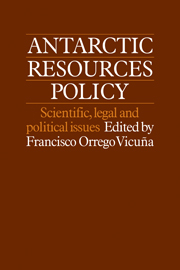Book contents
- Frontmatter
- Contents
- List of contributors
- 1 Antarctic resources policy: an introduction
- Part one The state of Antarctic knowledge and experience
- Part two The policy for the conservation of the living resources of Antarctica
- 7 Scientific and economic considerations relating to the conservation of marine living resources in Antarctica
- 8 The implementation of the Convention on the Conservation of Antarctic Marine Living Resources: needs and problems
- 9 The regime for the conservation of Antarctica's living resources
- 10 The Canberra Convention: objectives and political aspects of its negotiation
- Part three The policy for the exploration and exploitation of the mineral resources of Antarctica
- Part four Issues on Antarctica and the law of the sea
- Part five The policy for Antarctic cooperation
9 - The regime for the conservation of Antarctica's living resources
Published online by Cambridge University Press: 06 July 2010
- Frontmatter
- Contents
- List of contributors
- 1 Antarctic resources policy: an introduction
- Part one The state of Antarctic knowledge and experience
- Part two The policy for the conservation of the living resources of Antarctica
- 7 Scientific and economic considerations relating to the conservation of marine living resources in Antarctica
- 8 The implementation of the Convention on the Conservation of Antarctic Marine Living Resources: needs and problems
- 9 The regime for the conservation of Antarctica's living resources
- 10 The Canberra Convention: objectives and political aspects of its negotiation
- Part three The policy for the exploration and exploitation of the mineral resources of Antarctica
- Part four Issues on Antarctica and the law of the sea
- Part five The policy for Antarctic cooperation
Summary
Antarctica's living resources: history and major problems
Man went to the Antarctic continent, islands and adjacent waters primarily for economic reasons. Lured by Cook's tales, seal hunters began exploring the subantarctic islands in the last quarter of the eighteenth century. They quickly plundered the fur seal colonies of South Georgia, the Malvinas (Falkland Islands) and the South Shetland Islands. By 1820, the almost complete disappearance of this species in the subantarctic islands forced hunters to turn their attention to other species or to search out new hunting grounds. This was how, little by little, the American Nathaniel Palmer, the Russian von Bellingshausen, and the Englishmen Bransfield, Davis and Weddell drew near to the continent. Starting in 1830, the elephant seal, which was valued for its oil, became the quarry of all regular expeditions. Hunting was to continue until 1920, while it lasted on a very local scale until 1964 in South Georgia. In 1870, there was a revival of the hunting of fur seal colonies, and ten years later the species was once again threatened by extinction.
However, by the early 1900s another living resource – cetaceans – had become the focus of intensive economic activity. Cetaceans are more plentiful in Antarctic waters than anywhere else in the world, and their size makes them a more profitable source of oil than the elephant seal. They soon became the centre of activity in the region, while hunting of the elephant seal gradually abated.
- Type
- Chapter
- Information
- Antarctic Resources PolicyScientific, Legal and Political Issues, pp. 139 - 148Publisher: Cambridge University PressPrint publication year: 1983
- 1
- Cited by



